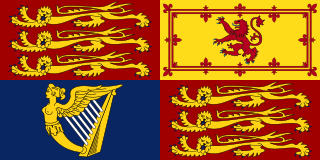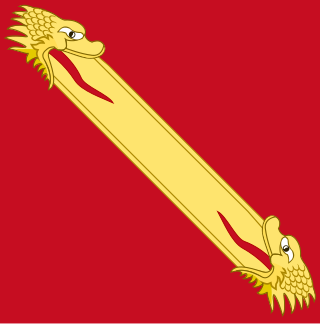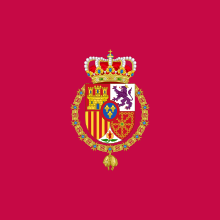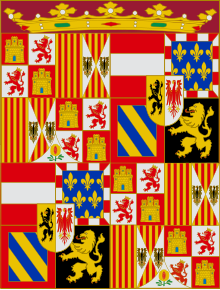
Felipe VI is King of Spain. In accordance with the Spanish Constitution, as monarch, he is head of state and commander-in-chief of the Spanish Armed Forces, holding the military rank of captain general, and also plays the role of the supreme representation of Spain in international relations.

The monarchy of Spain or Spanish monarchy is the constitutional form of government of Spain. It consists of a hereditary monarch who reigns as the head of state, being the highest office of the country. The current King is Felipe VI since 19 June 2014, after the abdication of his father, King Juan Carlos I.

The royal standard of the United Kingdom is the banner of arms of the monarch of the United Kingdom, currently Charles III. It consists of the monarch's coat of arms in flag form, and is made up of four quarters containing the arms of the former kingdoms of England, Ireland, and Scotland. There are two versions of the banner, one used in Scotland in which the Scottish quarters take precedence, and one used elsewhere in which the English quarters take precedence.

The national flag of the Portuguese Republic, often referred to as the Portuguese flag consists of a rectangular bicolour with a field divided into green on the hoist, and red on the fly. A lesser version of the country’s national coat of arms stands in the middle of the Portuguese armillary sphere and shield, centered over the colour boundary at equal distance. The flag was announced in 1910, following the 5 October 1910 revolution, inspired by the colours of the Republican Party and the design of radical conspiratorial society Carbonária.

The flag of Spain, as it is defined in the Constitution of 1978, consists of three horizontal stripes: red, yellow and red, the yellow stripe being twice the height of each red stripe. Traditionally, the middle stripe was defined by the more archaic term of gualda, and hence the popular name la Rojigualda (red-weld). That middle stripe bears the Coat of Arms.
The royal standards of Canada are a set of heraldic flags used by members of the Canadian royal family to denote the presence of the bearer within any vehicle, building, or area within Canada or when representing Canada abroad. All are based on a escutcheon of the coat of arms of Canada, the arms of dominion of the Canadian monarch.

In military organizations, the practice of carrying colours, standards, flags, or guidons, both to act as a rallying point for troops and to mark the location of the commander, is thought to have originated in Ancient Egypt some 5,000 years ago. The Roman Empire also made battle standards reading SPQR a part of their vast armies. It was formalized in the armies of Europe in the High Middle Ages, with standards being emblazoned with the commander's coat of arms.
The Spanish royal family constitutes the Spanish branch of the House of Bourbon, also known as the House of Bourbon-Anjou. The royal family is headed by King Felipe VI and currently consists of the King; Queen Letizia; their children, Leonor, Princess of Asturias, and Infanta Sofía; and Felipe's parents, King Juan Carlos I and Queen Sofía. The royal family lives at the Zarzuela Palace in Madrid, although their official residence is the Royal Palace of Madrid. The membership of the royal family is defined by royal decree and consists of: the King of Spain, the monarch's spouse, the monarch's parents, his children, and the heir to the Spanish throne.

The coat of arms of the King of Spain is the heraldic symbol representing the monarch of Spain. The current version of the monarch's coat of arms was adopted in 2014 but is of much older origin. The arms marshal the arms of the former monarchs of Castile, León, Aragon, and Navarre.

The blazon of the coat of arms of the Princess of Asturias is given by a Royal Decree 979 on 30 October 2015 which was an amendment of the Royal Decree 1511 dated Madrid 21 January 1977, which also created her guidon and her standard.

Portuguese heraldry encompasses the modern and historic traditions of heraldry in Portugal and the Portuguese Empire. Portuguese heraldry is part of the larger Iberian tradition of heraldry, one of the major schools of heraldic tradition, and grants coats of arms to individuals, cities, Portuguese colonies, and other institutions. Heraldry has been practiced in Portugal at least since the 12th century, however it only became standardized and popularized in the 16th century, during the reign of King Manuel I of Portugal, who created the first heraldic ordinances in the country. Like in other Iberian heraldic traditions, the use of quartering and augmentations of honor is highly representative of Portuguese heraldry, but unlike in any other Iberian traditions, the use of heraldic crests is highly popular.

The Cross of Burgundy is a saw-toothed form of the Cross of Saint Andrew, the patron saint of Burgundy, and a historical banner and battle flag used by holders of the title of Duke of Burgundy and their subjects.

In heraldry and vexillology, a heraldic flag is a flag containing coats of arms, heraldic badges, or other devices used for personal identification.

The Royal Bend of Castile was the heraldic flag of the monarchs of the Crown of Castile, a personal banner of military use, distinctive indicating to the troops the presence of the monarch and allowed them to have identified his position in the battles. This insignia, who joined in the symbolism of the king of Castile to heraldic flag with the Castile and Leonese arms, was created in 1332 by the king Alfonso XI of Castile, although its origin probably would go back to one of the primitive symbols of the Counts of Castile, which had consisted of a gold bend on gules (red). The dragantes appeared on the handpiece or baton when Scipio brought the Roman legions to Hispania.

Prince of Spain was the title created by law on 22 July 1969 for Prince Juan Carlos de Borbón, the designated successor of Generalísimo Francisco Franco. Juan Carlos held the title until 22 November 1975, when he became King of Spain following the death of Franco. The only person to hold this title was Juan Carlos; the title given to the heir-apparent or heir-presumptive to the Spanish throne has since been Prince of Asturias or Princess of Asturias.

The Coat of arms of the Prince of Spain was set out in the Spanish Decree 814 of 22 April 1971, by which the Rules for Flags, Standards, Guidons, Banners, and Badges were adopted.

The Eagle of Saint John is a heraldic eagle associated mostly with the Catholic Monarchs which was later used during Francoist Spain (1939–77) and the Spanish transition to democracy (1977–81). It is sable with an or halo and feet of gules.

The coat of arms of Castile was the heraldic emblem of its monarchs. Historian Michel Pastoureau says that the original purpose of heraldic emblems and seals was to facilitate the exercise of power and the identification of the ruler, due to what they offered for achieving these aims. These symbols were associated with the kingdom, and eventually also represented the intangible nature of the national sentiment or sense of belonging to a territory.

Infante of Spain is a royal title normally granted at birth to the children of reigning and past Spanish monarchs, and to the children of the heir to the Crown. Individuals holding the title of infante also enjoy the style of Royal Highness.















































